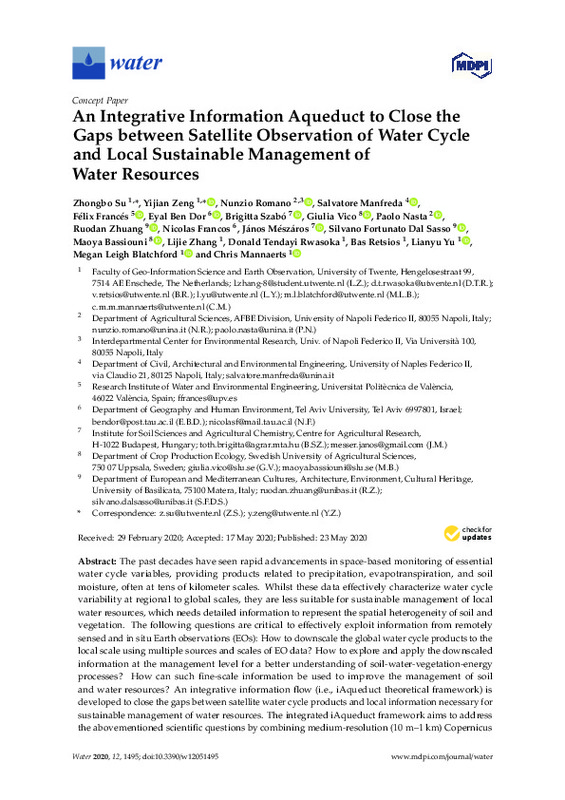Su, Z.; Zeng, Y.; Romano, N.; Manfreda, S.; Francés, F.; Ben Dor, E.; Szabó, B.... (2020). An Integrative Information Aqueduct to Close the Gaps between Satellite Observation of Water Cycle and Local Sustainable Management of Water Resources. Water. 12(5):1-36. https://doi.org/10.3390/w12051495
Por favor, use este identificador para citar o enlazar este ítem: http://hdl.handle.net/10251/176100
|
Título:
|
An Integrative Information Aqueduct to Close the Gaps between Satellite Observation of Water Cycle and Local Sustainable Management of Water Resources
|
|
Autor:
|
Su, Zhongbo
Zeng, Yijian
Romano, Nunzio
Manfreda, Salvatore

 Francés, F.
Ben Dor, Eyal
Szabó, Brigitta
Vico, Giulia
Nasta, Paolo
Zhuang, Ruodan
Francos, Nicolas
Meszaros, Janos
Dal Sasso, Silvano Fortunato
Bassiouni, Maoya
Zhang, Lijie
Francés, F.
Ben Dor, Eyal
Szabó, Brigitta
Vico, Giulia
Nasta, Paolo
Zhuang, Ruodan
Francos, Nicolas
Meszaros, Janos
Dal Sasso, Silvano Fortunato
Bassiouni, Maoya
Zhang, Lijie
|
|
Entidad UPV:
|
Universitat Politècnica de València. Departamento de Ingeniería Hidráulica y Medio Ambiente - Departament d'Enginyeria Hidràulica i Medi Ambient
|
|
Fecha difusión:
|
|
|
Resumen:
|
[EN] The past decades have seen rapid advancements in space-based monitoring of essential water cycle variables, providing products related to precipitation, evapotranspiration, and soil moisture, often at tens of kilometer ...[+]
[EN] The past decades have seen rapid advancements in space-based monitoring of essential water cycle variables, providing products related to precipitation, evapotranspiration, and soil moisture, often at tens of kilometer scales. Whilst these data effectively characterize water cycle variability at regional to global scales, they are less suitable for sustainable management of local water resources, which needs detailed information to represent the spatial heterogeneity of soil and vegetation. The following questions are critical to effectively exploit information from remotely sensed and in situ Earth observations (EOs): How to downscale the global water cycle products to the local scale using multiple sources and scales of EO data? How to explore and apply the downscaled information at the management level for a better understanding of soil-water-vegetation-energy processes? How can such fine-scale information be used to improve the management of soil and water resources? An integrative information flow (i.e., iAqueduct theoretical framework) is developed to close the gaps between satellite water cycle products and local information necessary for sustainable management of water resources. The integrated iAqueduct framework aims to address the abovementioned scientific questions by combining medium-resolution (10 m-1 km) Copernicus satellite data with high-resolution (cm) unmanned aerial system (UAS) data, in situ observations, analytical- and physical-based models, as well as big-data analytics with machine learning algorithms. This paper provides a general overview of the iAqueduct theoretical framework and introduces some preliminary results.
[-]
|
|
Palabras clave:
|
Unmanned aerial system (UAS)
,
Soil moisture
,
Pedotransfer function (PTF)
,
Soil
spectroscopy
,
Ecohydrological modelling
,
Sustainable water resources management
|
|
Derechos de uso:
|
Reconocimiento (by)
|
|
Fuente:
|
Water. (issn:
2073-4441
)
|
|
DOI:
|
10.3390/w12051495
|
|
Editorial:
|
MDPI AG
|
|
Versión del editor:
|
https://doi.org/10.3390/w12051495
|
|
Código del Proyecto:
|
info:eu-repo/grantAgreement/Swedish Research Council Formas//2018-02787/
info:eu-repo/grantAgreement/MTA//BO%2F00088%2F18%2F4/
info:eu-repo/grantAgreement/AEI//PCI2019-103729//UN ACUEDUCTO DE INFORMACION INTEGRADORA PARA CERRAR LAS BRECHAS ENTRE LA OBSERVACION SATELITAL GLOBAL DEL CICLO DEL AGUA Y LA GESTION LOCAL SOSTENIBLE DE LOS RECURSOS HIDRICOS./
|
|
Agradecimientos:
|
The authors would like to thank the European Commission and Netherlands Organisation for Scientific Research (NWO) for funding, in the frame of the collaborative international consortium (iAqueduct) financed under the 2018 ...[+]
The authors would like to thank the European Commission and Netherlands Organisation for Scientific Research (NWO) for funding, in the frame of the collaborative international consortium (iAqueduct) financed under the 2018 Joint call of the Water Works 2017 ERA-NET Cofund. This ERA-NET is an integral part of the activities developed by the Water JPI (Project number: ENWWW.2018.5); the EC and the Swedish Research Council for Sustainable Development (FORMAS, under grant 2018-02787); Contributions of B. Szabo was supported by the Janos Bolyai Research Scholarship of the Hungarian Academy of Sciences (grant no. BO/00088/18/4).
[-]
|
|
Tipo:
|
Artículo
|









